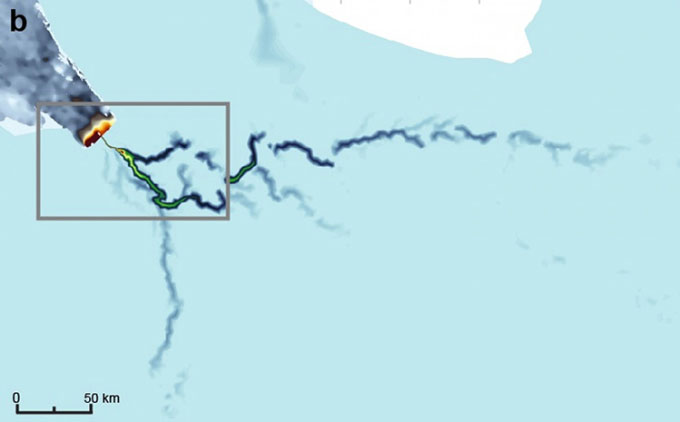Scientists Discover a Massive Subglacial River System Beneath Antarctica, Potentially Accelerating Ice Melt.
A study published in the journal Nature Geoscience on October 27, conducted by Imperial College London, the University of Waterloo in Canada, Universiti Malaysia Terengganu, and Newcastle University in the UK, provides new insights into Antarctica, reminding us that there is still much to learn about this continent.

Massive subglacial river system recently discovered beneath Antarctica’s ice. (Photo: Dow et al. 2022)
“When we first discovered lakes beneath the ice in Antarctica a few decades ago, we thought they were isolated from one another. Now, we are beginning to understand that there is a whole system down there, interconnected by vast networks of rivers,” said co-author Martin Siegert, a Professor at the Grantham Institute at Imperial College London, in a press release.
The study describes how a river, 460 km long, collects water from an area the size of Germany and France combined, indicating that the water flow beneath the Antarctic ice shelf is greater than scientists previously thought, which may make it more vulnerable to climate change.
“The study area contains enough ice to raise global sea levels by an additional 4.3 meters. The amount of ice that melts and the rate at which it does so are related to the slipperiness of the ice’s base. The newly discovered river system could significantly impact this process,” explained Siegert.
The discovery was made by combining hydrological models of the ice sheet with airborne radar measurement techniques that allow visualization beneath the ice. The research team focused on a largely unexplored and mostly inaccessible area, which contains ice from both East and West Antarctica, extending to the Weddell Sea.
“From satellite measurements, we know which areas of Antarctica are losing ice and how much, but we do not necessarily know why. This discovery could be a missing link in current predictive models. We may have underestimated the rate of ice melt by not accounting for the influence of these river systems,” added Christine Dow, the lead researcher and a Doctor from the University of Waterloo.
There are two main ways that water can enter beneath the ice sheets. One is through melting at the base due to friction as the ice moves over land and the Earth’s inherent heat. The other is through surface melting where water flows down through deep crevices.
In Antarctica, summer is considered too cold for surface melting to create deep crevices. Therefore, it was believed that only a small amount of water was present beneath the Antarctic ice sheets. The latest discovery refutes this hypothesis by demonstrating that there is enough water from basal melting to form significant river systems beneath the thick kilometers of ice.
The research team is gathering more information from surveys related to the newly discovered river system. They hope to adjust existing models for other regions to better understand how Antarctica may affect the planet.


















































